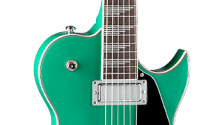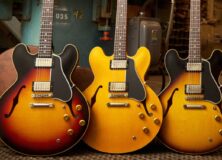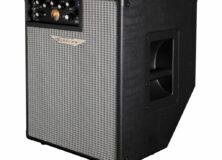
Read Time 5 Minutes
Stratocasters And The Guitarists That Made Them Famous
Guitars are the greatest thing since sliced bread. It’s a fact. It’s part of documented history. The thing about the guitar is there are so many varieties that have contributed to the guitar earning its unanimously agreed upon status as well as a legion of guitarists that have helped it get there. For this little tangent we’re focusing on one guitar and the many signature models guitarists have used to help the guitar get where it is today. Please welcome one of the most legendary models and a personal favorite of mine, the Fender Stratocaster.
The Gallery
Click any Image to Enlarge
Eric Johnson

Anyone that knows anything about Eric Johnson would in all likelihood know of his legendary attention to detail. There isn’t anything the guy could miss. You could cut a loud fart in the room and he’d be able to take a whiff and tell you what the last guitar you played was. Of course he generally uses this power for the good of mankind which he has harnessed into forming quite possibly the perfect Stratocaster.
While he plays a wide variety of Strats he does have a signature model that is designed to properly replicate the Strats of the late 50s. It is built of alder with a maple neck and fretboard. The pickups are Custom Shop-modified single-coils and it uses a vintage tremolo and tuners. The neck itself is thinner at parts and sculpted to properly fit in his hands.
David Gilmour

If I could sum up David Gilmour in one sentence I would say “one ear to rule them all.” That’s exactly what Gilmour brings to the table with miraculously appropriate melodies for any situation.
The body is alder with a maple neck and fretboard. The vintage Strat tremolo comes with a shorter than usual tremolo arm and it uses vintage tuners. The pickups are three single-coils with a Custom Hand-Wound Fat 50s in the neck, a Custom Wound in the middle, and a Seymour Duncan SSL-5 in the bridge.
Jeff Beck

Jeff Beck’s signature Strat comes with an alder body and a maple neck with a rosewood fretboard.
Though it looks to be armed with single-coil pickups each is actually a dual-coil ceramic Noiseless pickup.
Jim Root

This might seem like a trivial concern, but you know what’s cool about Jim Root? He’s in a modern metal band and he plays a Stratocaster. You just don’t see many Strats in metal compared to a lot of other brands, so the instrument by default doesn’t get associated with the genre very strongly. It’s cases like this that prove the Strat is a ready and willing accomplice to play as hard and heavily as you could wish.
Ritchie Blackmore

Ritchie Blackmore’s works in Deep Purple, Rainbow, and Blackmore’s Night have solidified him in a monopoly of all things bad ass. As if Rainbow Rising alone didn’t give him that lofty title, everything can be used to further corroborate these claims.
Blackmore’s signature Strat is an alder body with a maple neck and fretboard. The neck pickup is a Seymour Duncan Quarter Pound Flat SSL-4 single-coil, the middle is a non-active dummy, and the bridge is a reverse-wound/reverse-polarity Seymour Duncan Quarter Pound Flat SSL-4.
Dick Dale

Dick Dale’s signature is made from alder with a reversed headstock maple neck and a rosewood fretboard and three custom 50s single-coil pickups.
Bailing on the tone knobs and armed with just one master volume the Dick Dale signature also has an extra toggle switch that to activate the neck and middle pickups alone.
Dave Murray

You know what makes Dave Murray so awesome? He’s in Iron Maiden of course. No plot twist here or secret message. He’s in Iron Maiden and Iron Maiden is awesome. End of story.
Murray’s signature Strat is built out of alder with a maple neck and fretboard. The traditional three single-coil pickups have been replaced with two humbuckers and a single-coil. The neck is a DiMarzio PAF DP-103, the bridge is a DiMarzio Super Distortion DP100, and the middle is a vintage-style single-coil. The 5-way switch was also replaced with a simple 3-way switch.
Buddy Guy

Buddy guy is one of those fabled guys that set the bar for the people that came along and set the bar for everyone else. There’s no telling how many guitarists we wouldn’t have today if it weren’t for him. His trademark polka dot Strat has an alder body with a maple neck and it utilizes three Standard single-coil pickups.
Stevie Ray Vaughan

Stevie Ray Vaughan’s signature guitar is among the few that wasn’t formed through years and years of working with a company to narrow every detail down to match a specific criteria.
His signature is designed to replicate the guitar that he played the most which happened to be a guitar he had spontaneously purchased at a music store.
Yngwie Malmsteen

You know what? I think I’ve subtly given Yngwie some flack from time to time, but really I do have a lot of respect for the guy. He has a truly unique style with a unique sound and he’s one of those guys that just can’t be easily replicated in style and technique. And on top of all that he just plain doesn’t care what anyone else thinks because he’s gonna go and do what he does anyway. [ – Editor: Can I still call him YingYang Malcomspeed then?]
The things that make his guitar reek of Yngwie sound is the alder body with the maple neck with all its scalloped fret glory. The pickups are two DiMarzio HS-3 single-coils in the neck and bridge and a Standard Fender 70s-era single-coil in the middle.
Eric Clapton

Clapton’s among that elite group of guys that has played anything he can get his hands on in the name of getting “that sound”. An array of acoustics, Gibsons, Fenders, you name it. But this isn’t a gallery of every signature guitar Clapton has under his belt. Just his Stratocaster.
Clapton’s signature guitar has an alder body and maple neck and fingerboard are accompanied by three vintage Noiseless single-coil pickups.
Jimi Hendrix

Last, but not least, is perhaps the most iconic Strat from the guitarist with the musical Midas touch.
Jimi Hendrix couldn’t do anything without paving the way for trends to come and what began as him adapting a right-handed guitar so he could play more comfortably because a symbol decades later and still going.





